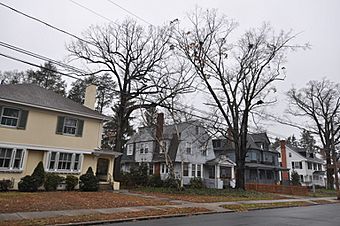West End Historic District (New Britain, Connecticut) facts for kids
Quick facts for kids |
|
|
West End Historic District
|
|

Vine Street
|
|
| Location | Roughly along Park Place, Vine, Forest, Lincoln, Liberty, Sunnyledge, Hart, Lexington, Murray, and Woodbine Sts., New Britain, Connecticut |
|---|---|
| Area | 75 acres (30 ha) |
| Built | 1884 |
| Architect | Davis, Frank I.; et.al. |
| Architectural style | Shingle Style, Colonial Revival, Tudor Revival |
| NRHP reference No. | 98001542 |
| Added to NRHP | December 24, 1998 |
The West End Historic District is a special neighborhood in New Britain, Connecticut. It's mostly a place where people live, located just west of the city center. This area was built in the late 1800s and early 1900s. It became a popular spot for important business and community leaders to live.
The district is shaped a bit like the letter "C" and wraps around the western side of Walnut Hill Park. It's famous for its beautiful old houses. In 1998, it was added to the National Register of Historic Places, which means it's an important historical site.
History of the West End District
After the American Civil War, New Britain grew very quickly. This was because of new ideas and factories making things like building hardware. In 1870, Walnut Hill Park was created. Famous landscape designers, Frederick Law Olmsted and Calvert Vaux, helped plan the park and the areas around it.
Much of this land belonged to Henry Russell. He was in charge of the park project. Between 1884 and 1908, he planned out streets near the park. Then, he sold pieces of land for people to build homes. This is how streets like Lincoln, Forest, Vine, and Hart Streets were formed. These streets are now the heart of the historic district.
Homes and Architecture
The houses in the West End Historic District are very interesting. They were built in popular styles from the early 1900s. These styles include Colonial Revival, American Foursquare, and Tudor Revival. Many homes have large yards and are set back from the tree-lined streets.
A local architecture company, Davis and Brooks, designed many of these houses. One special house on Vine Street, built in the Shingle style, later became the home of architect William Brooks. Many of the homes were built for the leaders of Stanley Works. This was New Britain's most important company, known for making tools and hardware.



